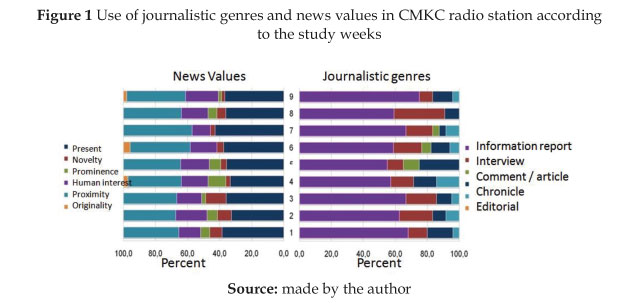
doi.org/10.15178/va.2017.138.120-140.
RESEARCH
USE OF JOURNALISTIC GENRES, NEWS VALUES AND INFORMATION SOURCES IN THE MEDIA IN SANTIAGO DE CUBA
USO DE GÉNEROS PERIODÍSTICOS, VALORES NOTICIA Y FUENTES DE INFORMACIÓN EN LOS MEDIOS DE COMUNICACIÓN DE SANTIAGO DE CUBA
USO DOS GÊNEROS JORNALÍSTICOS, VALORES NOTÍCIA E FONTES DE INFORMAÇÃO NOS MEIOS DE COMUNICAÇÃO DE SANTIAGO DE CUBA
Viviana Muñiz Zúñiga1 Graduated in Journalism, graduated from the Universidad de Orient in Cuba. Investigates since 2013 the processes of construction and establishment of the media agenda in Cuba; The implementation of the Information and Editorial Policy and the construction of the news in the Cuban media. http://www.redalyc.org/autor.oa?id=14461
Rafael Ángel Fonseca Valido1 Doctor of Communication Sciences. He graduated from the University of Orient in Cuba. It investigates the production-emission and reception-consumption processes of media messages, especially of a journalistic nature; As well as the optimization of the Cuban press organs.
1University of Orient, Cuba
ABSTRACT
This is a mixed study that characterizes the use of journalistic genres, news values and information sources in the provincial media in Santiago de Cuba. For this purpose, methods such as analysis-synthesis and the inductive-deductive method were used; and a content analysis was performed using the week constructed for 9 weeks to provincial press bodies. These data were triangulated with interviews and surveys to the journalists working in such provincial press bodies to determine their opinion about these elements. With the analysis of the results we could establish that information, reportage and commentary are used as genres, which coincides with the presence of news values such as present day, human interest and proximity. The routines to use these elements are linked to the profile of the analyzed media and their processes for making journalistic work. In the province, journalists use more documentary and institutional sources, which is due to their credibility to achieve a higher quality product.
KEY WORDS: Journalistic genres, news values, information sources, construction of news, productive routines, Cuba.
RESUMEN
La presente constituye un estudio mixto, que caracteriza el uso de los géneros periodísticos, los valores noticia y las fuentes de información en los medios provinciales de Santiago de Cuba. Para ello se emplearon métodos como el de Análisis-síntesis y el Inductivo-deductivo; y se realizó un análisis de contenido utilizando la semana construida durante 9 semanas a los órganos de prensa provinciales. Esos datos se triangularon con entrevistas y encuestas a los periodistas que en ellos laboran, para determinar qué opinión tienen sobre estos elementos. Con el análisis de los resultados se pudo establecer que se emplean la información, el reportaje y el comentario como géneros, lo que coincide con la presencia de valores noticia como la actualidad, el interés humano y la proximidad. Las rutinas de uso de estos elementos están vinculadas con el perfil del medio analizado, y sus procedimientos para elaborar los trabajos periodísticos. En la provincia los periodistas emplean más las fuentes documentales e institucionales, lo que se debe a la credibilidad de estas para lograr un producto de mayor calidad.
PALABRAS CLAVE: Géneros periodísticos, valores noticia, fuentes de información, construcción de la noticia, rutinas productivas, Cuba.
RESUMO
O presente constitui um estudo misto, que caracteriza o uso dos gêneros jornalísticos, os valores notícia e as fontes de informação nos meios provinciais de Santiago de Cuba. Para isso usaram métodos como o de analises-síntese e o indutivo-dedutivo; e realizou se uma analise do conteúdo utilizando a semana construída durante nove semanas aos órgãos da imprensa provinciais. Esses dados se triangularam com entrevistas e encostas aos jornalistas que neles trabalhavam para determinar que opiniões tinham sobre esses elementos. Com a analises dos resultados puderam estabelecer que usam a informação, a reportagem e o comentário como gêneros, o que coincide com a presença de valores noticia como a atualidade, o interesse humano e a proximidade. As rotinas de uso desses elementos estão vinculadas com perfil do meio analisado, e seus procedimentos para elaborar os trabalhos jornalísticos. Na província os jornalistas usam mais as fontes documentais e institucionais, devido à credibilidade destas, para lograr um produto de maior qualidade.
PALAVRAS CHAVE: Gêneros jornalísticos, Valor notícia, Fontes de informação, Construção da notícia, Rotinas produtivas, Cuba
Received: 29/06/2016
Accepted: 24/09/2016
Published: 15/03/2017
Correspondence: Viviana Muñiz Zúñiga. vivita@uo.edu.cu
Rafael Ángel Fonseca Valido. fonseca@uo.edu.cu
1. INTRODUCTION
Journalistic quality in different media is studied in a few pieces of research developed during the last 5 years (Mompart and Sampio, 2013; Mompart, Lozano and Sampio, 2013; De la Piscina, Gorosarri, Zabalondo and Agirre, 2014. Aguirre and Bernal, 2015, De la Torre and Téramo, 2015, Mompart, Lozano and Sampio, 2015, Reyes, González, Torrijos and Gordillo, 2015, Carballosa, Pavón and Rodríguez, 2016). These studies have evaluated the media product from different indicators such as the use of news values and news reporting criteria, information sources and journalistic genres; the productive routines and the conception of the professionals of the guild about the work they do.
Mompart and Sampio (2013) explain that the need to address journalistic quality has been linked to diverse methodological traditions, which in North America have a commercial nature, unlike the more informative European studies, with an idea linked to the amount of Information and the space dedicated by a medium to a set of facts. For example, in Spain, the Annual Report of the Journalistic Profession (Madrid Press Association, 2013) is published, which reflects the behavior of factors such as the labor market, the scenarios of professional performance based on the economic crisis, the working conditions and the attitude towards the transformations imposed by Information and Communication Technologies.
In Cuba, there are studies that have evaluated the use of elements that allow the enrichment of the journalistic product (Rosquete, 2010, Colunga, 2011, Toledo, Medina and Hernández, 2015, Carballosa, Pavón and Rodríguez, 2016, Vicente, Rojas and Vicente, 2016), although there are urgent longitudinal studies that point to a systematization of these factors in regional (provincial) press organs.
For this reason, this piece of research delves into the use of journalistic genres, news values and information sources in audiovisual and printed media in the province of Santiago de Cuba, using the method of constructed week, through which 9 weeks of 2015 were selected. This quantitative result was triangulated with interviews and a survey of journalists’ perception of the use of these elements. In that sense, we posed as a research problem what follows: What are the characteristics of the use of journalistic genres, news values and information sources in the provincial press organs in Santiago de Cuba during the year 2015?
2. OBJECTIVES
The general objective of this study is to characterize the use of journalistic genres, news values and information sources in the provincial press organs in Santiago de Cuba during the year 2015. In order to fulfill this macro purpose, the following research tasks or specific objectives were established:
–Determine the use of news, opinion and interpretive journalistic genres in the works published by the analyzed media.
–Determine the use of news values in the analyzed sample.
–Determine the use of institutional, personal and documentary information sources in the chosen media.
–Evaluate the perception of journalists regarding the routines of use of journalistic genres, news values and information sources in their respective media.
3. METHODOLOGY
This study uses a mixed research design, as it combines quantitative and qualitative procedures for the characterization of the use of journalistic genres, news values and information sources in the media in Santiago. Therefore, methods such as Analysis-synthesis are applied in processing the consulted bibliography; and the inductive-deductive method in establishing generalities taking into account the particularities and vice versa. Accordingly, techniques such as quantitative content analysis were used, on which percentages were calculated and the non-parametric binomial test was used to establish the significance levels of the values found. The results of this analysis were triangulated with the application of a survey to a sample of 64 active journalists from the province, in which they were asked about the use of journalistic genres, news values and information sources in the works they published in their respective media. Subsequently, a semi-standardized interview was conducted with 38 journalists in order to carry out a qualitative assessment and the participant observation was used for the period of two months in the media to evaluate some routines of use of these elements. As previously mentioned, for the content analysis, the constructed week method was used, which “allows us to obtain a random sample of media information by expanding the range of its selection. This avoids distortions typical of a reduced information moment, while at the same time maintaining the marks of the editorial agenda “(Teramo, 2006, p.59). With this methodology, 349 works were analyzed for 9 weeks in the CMKC station, taken from the daily news report. At Tele Turquino Telecenter, 246 papers published in Tele Noticias, Revista Santiago and Última Hora news programs were evaluated; and, from Sierra Maestra newspaper, we took 198 works of its printed version.
4. RESULTS AND DISCUSSION
4.1. Theoretical notes
Reality provides the journalist’s perspective with a wide range of contents, on which to discern their importance for the people who write. This is explained by theorist Walter Lippmann (1969) who pointed out that information is so difficult to obtain that it is beyond the resources of the daily press. Therefore, some authors (Gomis, 1991, Pineda and Molero, 2015, Vicente, Rojas and Vicente, 2016) argue that the role of the media as social mediators between the facts of reality and people is more complete the greater their ability or initiative in their dissemination is. In this sense, the author (Gomis, 1990) refers that a medium can “generate” facts when it potentiates one specific situation to the detriment of another, framing and establishing a thematic agenda (Mompart, Lozano and Sampio, 2013, De la Piscina, Gorosarri , Zabalondo and Agirre, 2014). Grossi (1983) pointed out that the media are co-producers of the journalistic product, because they are not limited to linearly transmitting unfolding events (McCombs, 2006) to society; the role of the gatekeeper (Alsina, 1993) standing out in selecting and making the informative message hierarchical. In this sense, journalistic genres, news values and information sources are three important elements in framing the news event, and they are the subject of analysis of numerous pieces of research that make proposals focused on journalistic quality and evaluation of the media product ( Aguirre and Bernal, 2015, Hernández, 2015, Mompart, Lozano and Sampio, 2015, Carballosa, Pavón and Rodríguez, 2016). The three elements make up the complex news producing process, which to Golding and Elliot (1979) begins with planning, data collection, selection and making elements and production of the material hierarchical.
4.1.1. Journalistic genres
Some authors (Cardoso, 2008) recognize as journalistic genres certain basic forms that characterize the content and its structure, as well as the linguistic, literary and artistic methods and means for elaborating the discourse in correspondence with the functions and intentionality assumed by the organ of press and the journalist. In this sense, other authors (Serrano, 1982) argue that the main differentiation that can be observed in these genres comes from the objective of the communicative product that is elaborated, and therefore from the social function that it will fulfill: whether it is informative, educational, interpretive, opinion-based, playful or instrumental (Cardoso, 2008). In this sense, the tendency to hybridization among journalistic genres is an inherent characteristic of the evolution of the press (Cardoso, 2008; Ribeiro, 2016), which is accentuated in the case of digital media, thanks to hypertextuality, multimedia and interactivity:
“On the one hand, with hypertextuality, permeability among journalistic texts intensifies and the ability to associate with one another extends ... Also, the emergence of multimedia also brings with it the combination of languages developed independently for decades in the different means of communication “(Ribeiro, 2016, p.267).
The study of Ribeiro (2016) analyzes the use of cyber-journalistic genres in blogs of journalists, systematizing the evolution of their nomenclature since 2000. One of the tendencies of research and realization of journalistic genres is the so-called “Slow journalism” (Cedillo and Carretero, 2015, p. 37), which “emerges as a reaction to the dominant tendency to immediacy and exclusive and invites us to rethink the times necessary to produce and consume rigorous, creative information and quality”. According to the authors, the future of this type of practice is a brief piece of news, cheap and easy to produce with the support of technologies: that will coexist with specialized journalism that will use more extensive texts with a high aesthetic content. Although this trend might be more costly than the traditional experience, it would achieve greater understanding with the audiences, giving them a product with a higher level of finishing in the writing and preparation.
4.1.2. The use of information sources
Lorenzo Gomis (1991) explains that, in general, the facts are covered by the media have previously been chosen by those interested in this fact, a criterion corroborated by practical studies in different media (Alcaraz, 2012; Ibáñez, Alonso and Hernández, 2015, Macias, 2015). In this sense, there are reasons why the relationship occurs in this way: gratuitousness - in some cases - in the dissemination of the fact, the interest of the source to circulate facts considered to be able become news, and therefore, to interest the public (Gomis, 1991). Authors such as León Sigal (1973) and Brown, Bybee, Wearden and Straughan (1987) have shown that information usually arrives through press releases and other usual channels; so they confirmed that the media have less control over the development of their agendas than they really do. In this sense, the capacity of political sources to establish thematic priorities is highlighted, through the “artificial production of events” (Grossi, 1981), which the journalist uses and imbues with the relevance of the subject at the public level. To this author, the source-journalist relationship manifests itself in an ambivalent way: the sources regulate the balance and represent the mutable confines between the media and reality. At this point, it is necessary to point out that this relationship has a high component of consensus and ideological negotiation, because the source will want the event to be reflected in a specific way, and the journalist has a double social commitment. Some authors (Reyes, 2006) agree that the sources can be classified as documentary and non-documentary. Among the former are important and valuable documents that are part of the culture and historical memory that regularly contain textual information. Due to the immediate immediacy of the journalist’s job, the documentary bibliographic review made possible by the Internet is a frequent tool in daily work. Non-documentary sources, as the name implies, can be found in any format other than a document, whether it is a recording, a photo, etc. Information sources can also be classified as official and unofficial (Alsina, 1993).
The establishment and validation of a source strategy is crystallized in their daily use. Daily, journalists come to their sources, and in most cases, those institutionalized or official sources that reinforce and legitimize the veracity of the message that is given (García, 2013). Other classifications refer to the relevance level of the source or to their interest in informing something (Cardoso, 2008). The sources interested in reporting seek the media, or someone inserted within them that communicates with the journalist in charge of the topic related to its information. This type of source can be ordinary people, specialists in smaller degree, artists, research centers, among others. According to Cardoso (2008), sources can be accessed in three different ways:
–Institution-oriented Search
–Disseminators or press departments
–Personal contact
Keeping a good relationship with sources is crucial for prompt notification and delivery of first-hand, top-quality information. But this “good” relationship must keep a professional distance between both journalists and sources – since if you lose professional distance with sources, institutions and officials, distortions are created that prevent you from knowing where your identity and your mission are. This reduces the capacity for self-regulation and then turns to the journalist’s concept as “spokesperson of the organ” (García, 2013). The constant use of the same legitimate source legitimates it before society, gives it certain status and social relevance.
4.1.3. News values
The author of the text Journalism, news and newsworthiness (Martini, 2000) defines news as the particular construction of information discourse that narrates generally public factual events. As an image of the social present (Gomis, 1991), it is the story of an event that involves or affects individuals in society. If news values are taken into account, news can be defined as the journalistic construction of an event whose novelty, unpredictability and future effects on society place it publicly for its recognition (Martini, 2000). News values have been used by journalists as one of the most important filters that a fact must overcome to become news. “News values are ... practical rules that include a corpus of professional knowledge that implicitly, and often explicitly, explains and directs work processes in writing” (Golding and Elliott, 1979, p.59). They are subject to the communicative context (Orosa and Santorum, 2012) and facilitate the rapid development of production processes within newsrooms. It is valid to clarify that an event does not necessarily have to have all these values, although the more values are included, the greater the advantages of being incorporated into the productive process of the media and becoming news. Some of the most discussed (Martini, 2000) are present day, immediacy, truthfulness, collective and human interest, prominence, originality, and closeness. However, other qualities of the event in relation to the productive processes can be pointed out:
–Understanding and intelligibility of an event Gomis (1991). An understandable event usually allows us to show results: Gomis (1991) adds that results are the ideal feature of news because, this way, an event is defined as such, it is public and has repercussions in the future.
–Credibility.
–Brevity, which is related to the qualities noted above and consists of the possibility of building a story in a few lines or at least directly.
–Periodicity. The facts that are habitual and periodically appear in the media are easier to construct and also to be interpreted by the public that consumes them.
–Exclusivity or primacy allows the success of catching novelty before others do, but implies the ability to contact legitimate and privileged sources and to read the facts in a productive way (Martini, 2000).
4.2. Use of journalistic genres and news values in the media in Santiago
In the case of CMKC radio station, the most used genre was Information, with 73.9% of the works, followed by Commentary (11.2%), interview (8.0%) and Reportage (4.3 %). This result indicates that this radio station greatly favored the interpretation of events through facts, which is closely related to the format of the medium: radio offers sound resources and the time factor is less limited than in television or space in newspapers (only 8 pages in tabloid format once a week). This corresponds to the use of news values such as present day (39.0% of mentions), proximity (37.8%) and human interest (11.6%). As shown in Figure 1, both elements manifest themselves with relative temporal stability, as quantitative changes occur as revealed by content analysis.

A similar result was found in the telecenter, where the most used genre is Information with 78.5% of published works, and reportage with 13.0%. The most commonly used news values were proximity (39.0%) and present day (38.8%). Note how the use of genres and news values in these media differs somewhat, even though both have similar formats. As in the case of the radio station, the use of both elements is stable in the telecenter.
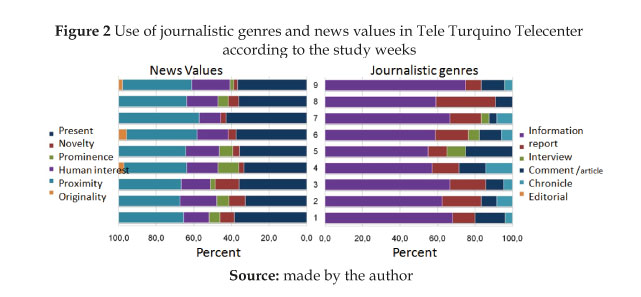
Finally, in newspapers, the most used genres were Information (63.6%), reportage (16.7%) and commentary (12.1%), which corresponds to the use of news values such as present day (36.5%), human interest (16.5%) and proximity (35.6%). In this case, the journalistic genres are mainly due to the space available in the medium and to its social function: firstly to inform, and then to analyze the news events that are presented, mainly due to its weekly nature.
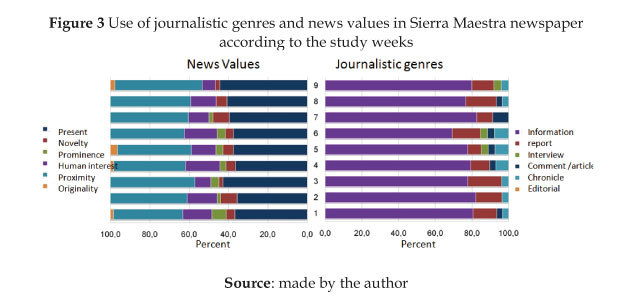
Table 1 and table 2 show the totals of the use of journalistic genres and news values with their respective relative frequencies and the result of the binomial test performed with the objective of establishing the level of significance of each one during the study weeks. The level used in both cases was 0.05.
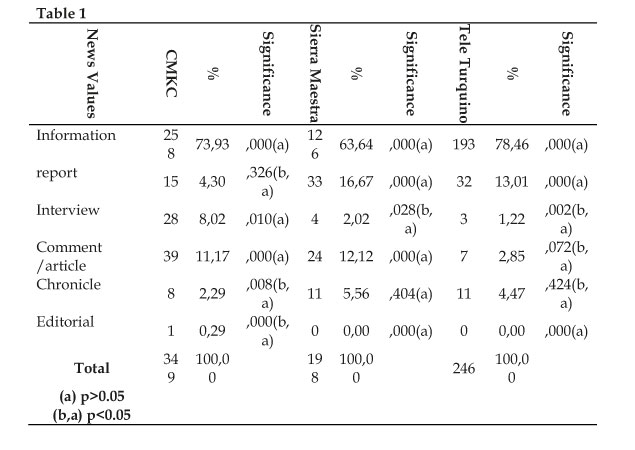
Content analysis showed that the percentage obtained in the use of the genres and news values were maintained regularly during the 9 studied weeks, which shows a possible temporary permanence of these elements. Also, the most used genre in these press organs is information, followed by others such as opinion, commentary and interpretation, such as reportage. This behavior is mainly due to routines of use in the media, closely linked to the professional practice of journalists. For example, on the radio, they pointed out in the interviews that “the vortex of work causes us to do the same thing and the same thing, the cassette is repeated every month.” Meanwhile, those on television say they lack depth to the kind of journalism they perform , and that topics should be dealt with in different ways and not as has always been done because, in a way, recipients are tired of seeing the same thing.
Therefore, interviewees explain that although the information sources provide important issues to the media, we also new proposals have to be injected into the agendas so that they do not behave in a static or semi-static way, as has been occurring in several cases.
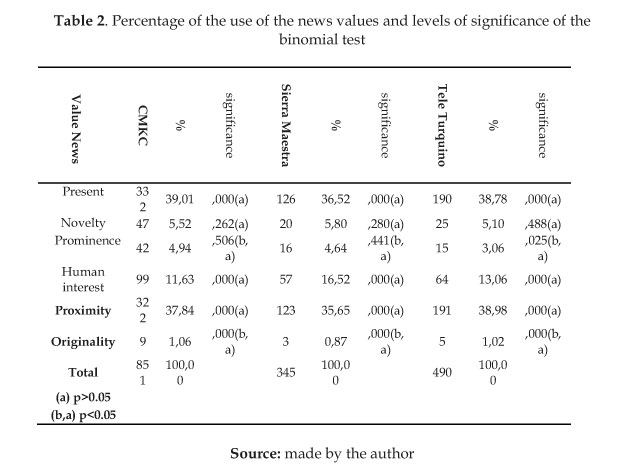
The news values most used in the three media were present day -what is related to the use of information as a gender-, proximity, mainly due to the nature of the analyzed products, which are aimed at the inhabitants of the province, because they are precisely media with provincial reach. This means that most of the journalistic products that are published are content close to the experience and living conditions of people, and not just geographically, as can be inferred. This element is also linked to the use of human interest as a news value, for the sake of making a more attractive product; journalists often resort to life stories of people who can stimulate the consumption of published works. In order to compare obtained information with content analysis, a survey was applied in which the journalists of the analyzed media were questioned about the use they make of journalistic genres and news values. As for the opinion on the possibility of exercising criticism in the medium in which they worked, the majority pointed out that it was regular (35.29% in the newspaper, 50.00% on the radio and 55.56% on television), although, in the case of the newspaper, the majority (47.06%) considered that it was good. In all three media, journalists considered it to be bad to a lesser extent. This result indicates that there are really no substantial institutional obstacles to work with a critical approach, because as noted in the interviews, “managers, sources and the Communist Party of Cuba promote the use of more critical journalistic genres and works, although this does not happen with all sources.” Obviously, there are information sources that are more closed when providing information, and sometimes limit the journalists to blunt negative elements in their work. This conditions the use of interpretive and opinion-based journalistic genres. An element observable in the interviews was the space available for publication: “many times journalists want to do a deeper, extensive work, but because of a space problem, they do not publish it”. This happens mostly in the newspaper in its printed version, since they only have 8 pages in a tabloid format once a week. However, the radio is influenced by the editing routines of the works, the planning of the recording studios is often contrary to the production of these more “delicate” genres by the sound realization that they carry. On television, “journalists usually act on schedule, but also the editing cubicle schedule is scarce, because sometimes the journalist only has one hour to edit a three-minute job, and we know that, depending on the subject and the visual resources, it takes more time.” Moreover, journalists were questioned in the survey about the frequency of the use of journalistic genres and news values in their medium according to their opinion. Figure 4 shows the criteria of newspaper professionals; it should be noted that the quantitative results partially coincide with those obtained in the content analysis. Logically, this result is also related to the conception of each journalist about news values and about what should be their use in the works they produce, remember that this is a socially created product.
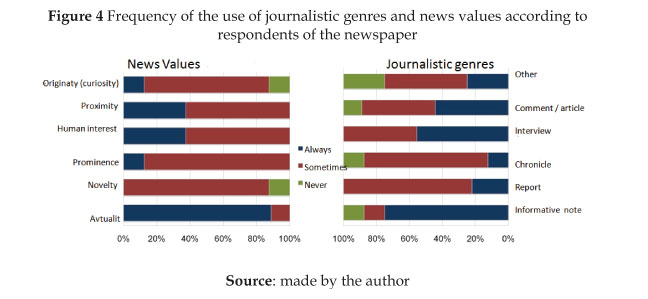
However, what we found in the case of the newspaper in terms of perception was very similar to what we found on the CMKC station. Note in figure 5 that journalists consider that they always use immediacy and proximity as news values, which is in line with the type of medium we evaluate.
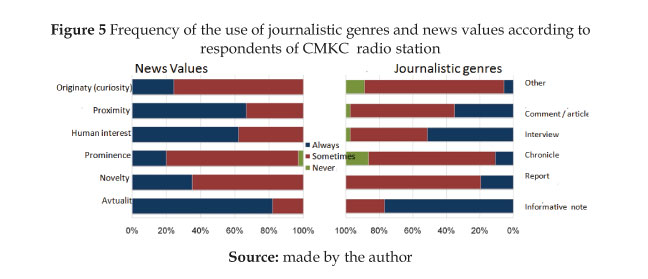
This regularity in the result is due to a homogeneous and regular conception of the phenomenon, which indicates that in the media there are similar conditions of production, regardless of the format in which works are produced. Figure 6 shows this particularity:
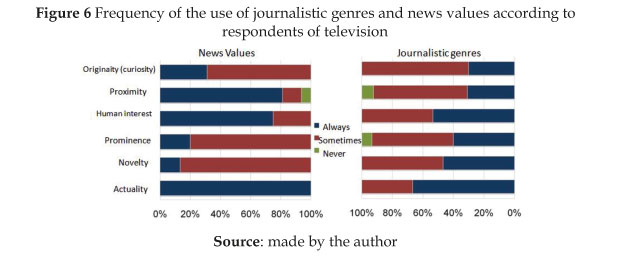
So far, both the content analysis and the survey and the interviews show a routine in the use of journalistic genres and news values with very similar characteristics in the studied press organs, which leads to the conclusion that, in the province, there is not only a unified conception about the use of both elements but also about its importance to enrich work in the media. Obviously, their use is related to factors that stem from the construction of the news in each organ, such as the organization of work, space and availability of material resources, sources dealt with by journalists and the capacity they have to do a higher quality product.
4.3. Use of sources of information
Information sources in the journalistic work are a powerful tool that allows the greatest amount of integration of elements in a news work. In the present study, we show the results of the methodological triangulation carried out from content analysis, the survey applied to the journalists and the interview in which they were questioned about their relationship with the institutional sources, the reasons for which they consulted a specific source and not another, etc. In the interviews, journalists said that information sources are important for the work they do because they offer different visions, perspectives, and information content, experiences that enrich their work; also serve to verify, prepare, complete and guide the process of construction of news, because they are part of one or another mode of the news event. 76.47% of the subjects surveyed in the newspaper indicated that they always use state institutions as a source, followed by 47.06% who claim to use the criterion of the people. Therefore, in content analysis, 48.7% of the sources used were precisely the institutional ones, followed by the personal ones (the public), with 15.8%. Figure 7 shows the results obtained in content analysis of the media, and Figure 8 shows the responses of the journalists in the survey:
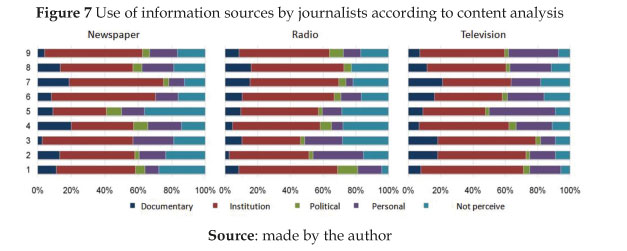
On the radio, conversely, 55.56% of journalists claim to use the people from Santiago as their source, and 50.00% say they use state institutions. However, in content analysis, 52.5% of the sources used were state, and only 12.4% personal.
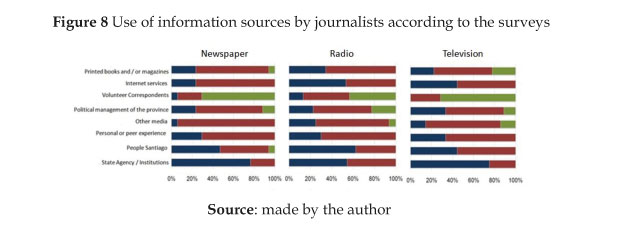
Finally, in the case of the telecenter, 66.67% of the journalists indicated that they always use state agencies as sources, and that sometimes they resorts to the population or the Internet (55.56% respectively).
In the formation of the agenda of a journalist or a medium, there are many information sources, whose use may vary depending on the personal interest of the journalist or the media in a general sense. For example, 23.53% of respondents in the newspaper say that they always use the political leadership of the province, Internet websites and printed books and / or magazines as sources; while on the radio, 25.00% say they rely on personal or colleagues’ experience, and 22.22% say they use what other media publish. This is because documentary sources are considered “essential” in the work of journalists, mainly because of the need to do the journalistic work with the immediacy that it requires; due to the non availability or accessibility of certain documents and the specificities of the work environment (television, printed or digital press, radio). However, in the interviews it was possible to determine that the use of institutional information sources is mainly due to the search for data reliability, the specialization of the source -conditioned by the previous element- and the hierarchical level it has. In this regard, it is worth noting that some value the use of a particular source in response to the addressed facts: “perhaps a person from the street, outside an institution, can speak better of bread quality than the bakery manager himself” . For that reason, we emphasize that the use of sources must be matched to the intention of the journalist. On the other hand, we observe that the data from content analysis do not coincide with the criteria provided in the surveys, which leads us to consider that journalists keep an unrealistic perception of their relationship with the public, although they are aware that they use more institutional sources. Finally, in content analysis, there is a considerable percentage (19.9% in the radio, 20.1% in the newspaper, and 10.4% on television) of sources that are not mentioned, that is, that are not cited in the journalistic works; In addition, that the percentage of use of other sources mentioned herein is significantly lower than that of the institutions, which presumably indicates that the use of several information sources in the same communicative product is poor. Regarding access to institutional information sources, RSB 232, that regulates, among other elements, the relationship between journalists and information sources, refers in its text to the main difficulty faced by our communicators in working with them. Officials and state officials at all levels often avoid contact with the press, because they do not consider themselves authorized to broadcast certain pieces of information of interest that are not really secrets, and sometimes, when they access it, impose excessive limitations. In fact, the cited document was written in 2007, and even today these difficulties have not been solved. Professionals believe that working with sources is a great help, because a close working relationship is created between them and institutions. This is valid to some extent, as there are many journalists whose sources keep direct contact, close communication; and then information flows better. But, unfortunately, not all sources do what they should, sometimes they even become the main obstacle, not giving the necessary data or distorting them. It also happens that certain organs that are involved in some materials assume their revision once finished; a permissible action if there is a specialized term, and provided the reporter is not told what to write or not. However, in situations like this, the guiding role of the Communist Party of Cuba is helpful, often mediating so that information is finally provided: “by putting a lock on the journalist, they also put it on the Party. Institutions usually collaborate.” Finally, the journalists made reference in the interviews to sectoralization as a fundamental element in the relationship with the sources. In this sense, criteria did not coincide with each other, since some say that accommodating to a given source is detrimental to journalistic work -due to interpersonal relationships and the confidence that is gained over time-; others see this aspect as something positive because, to them, open communication with the source is the best option.
5. CONCLUSIONS
After the analysis carried out in this study, we can arrive at the following conclusions: the use of informative, opinion-based and interpretive journalistic genres in the works published by the media in the province is determined by routines established within each organ, but said routines work similarly in all. That is why in Sierra Maestra newspaper, CMKC and Tele Turquino telecenter, we can observe that the most frequent genres are information, reportage and commentary. This is related to the use of news values as a tool to provide journalistic work with elements that are attractive to the public and other media. In this sense, the most used values are immediacy, proximity and human interest, which could be observed in the results of the content analysis made to the media. In the triangulation of these data with the surveys and the interview to the journalists, we could see that the professionals similarly conceive the usefulness of these elements, especially of news values. Therefore, we find similar criteria in the results of these techniques. It was evaluated that the relationship of journalists from Santiago de Cuba to the information sources is subject to elements such as the type of source used in journalistic work, and the characteristics or structural and organizational characteristics of the media. In a general sense, the use of documentary sources predominates in search of balance and obtaining a more finished informative product. It was possible to verify that, although exchange with the oral or living sources (whether specialized or not in a particular topic of a sphere or sector) is manageable, it does not rule out the fact that it has some degree of uncertainty and some unavailability. It is also conceived that work in the media would be impossible without the contribution of sources because, without them, the information is poor, lacking in truthfulness, reliability and level of verification.
REFERENCES
1. Aguirre C, Bernal JD (2015). Contenidos periodísticos digitales: hacia un modelo de medición de calidad. Revista ComHumanitas, 5(1):75-90.
2. Alcaraz LG (2012). El cambio climático en la prensa local. Agenda informativa, valores noticiosos y encuadres periodísticos en dos diarios argentinos. Razón y palabra, 80:36-29.
3. Alsina MR (1993). La construcción de la noticia. Barcelona: Paidós.
4. Andrade ES (2015). La realidad por escrito. Reflexiones en torno al análisis del discurso periodístico. Comunicación y Sociedad, 40.
5. Asociación de la Prensa de Madrid. (2013). Informe anual de la profesión periodística. Recuperado de http://www.apmadrid.es/publicaciones/informe-anual-de-la-profesion-periodistica.
6. Brown JD, Bybee CR, Wearden ST, Straughan DM (1987). Invisible power: Newspaper news sources and the limits of diversity. Journalism and Mass Communication Quarterly, 64(1):45.
7. Builes IA (1996). La influencia de las rutinas productivas en la construcción del acontecer nacional: el caso de Siglo 21, periódico de Guadalajara, México. Comunicación y Sociedad, 28:83-114.
8. Carballosa BR, Pavón LB, Rodríguez EV (2016). La calidad de los productos periodísticos: una experiencia para su evaluación. Razón y palabra, (92):13-17.
9. Cardoso H (2008). Investigación y creación periodística. La Habana: Editorial Pablo de la Torriente.
10. Cedillo GR, Carretero AB (2015). Periodismo lento (slow journalism) en la era de la inmediatez: Experiencias en Iberoamérica. El profesional de la información, 24(4):451-462.
11. Colunga M (2011). Mediaciones sobre el contenido de los medios que inciden en la relación entre la agenda mediática del periódico Adelante y la agenda pública de sus lectores potenciales. (Tesis inédita de licenciatura). Universidad de Camagüey, Cuba.
12. Comité Central del Partido Comunista de Cuba. (2007). Orientaciones del Buró Político del Comité Central del Partido Comunista de Cuba para incrementar la eficacia informativa de los medios de comunicación masiva del país. (Documento limitado).
13. De-la-Piscina TR, Gorosarri MG, Zabalondo B, Agirre A (2014). Periodismo de calidad en tiempos de crisis: Un análisis de la evolución de la prensa europea de referencia (2001-2012. [Quality journalism in times of crisis: An analysis of the evolution of the European reference press (2001-2012)]. Revista Latina de Comunicación Social, 69, 248.
14. De-la-Torre L, Téramo MT (2015). La calidad de la información periodística: estrategias para su observación. Coincidencias y divergencias entre los medios y el público. Estudios sobre el Mensaje Periodístico, 21:135-144.
15. Díaz NS, González MDM, Gutiérrez-Coba L, Cardona AS (2016). Análisis de la cobertura de noticias sobre alcoholismo y drogadicción en la prensa colombiana. Health and Addictions/Salud y Drogas, 16(1):41-48.
16. Falla JMPP, Ramírez RMR (2015). Tratamiento Periodístico de las Noticias en Diarios. Casos de Niños y Adolescentes en Conflictos con la Ley. Lambayeque–2013. Revista Científica PAIAN, 6(1).
17. García J (2013). Revolución, socialismo, periodismo. La prensa y los periodistas cubanos ante el siglo XXI. La Habana: Pablo de la Torriente.
18. Golding P, Elliott PRC (1979). Making the news. Longman Publishing Group.
19. Gómez LP (2016). El papel del periodista en la información política electoral y uso de Twitter en la difusión de contenidos. Revista de la Asociación Española de Investigación de la Comunicación, 3(5).
20. Gomis L (1991). Teoría del periodismo. Cómo se forma el presente. España: Paidós Comunicación.
21. González ADL, Robles FA, Prieto MC, Avilés JAG (2015). Ranking de innovación periodística 2014 en España: Selección y análisis de 25 iniciativas. El profesional de la información, 24(3):235-245.
22. González JM (2016). Periodismo Interpretativo: precisiones en torno a un género. Cuadernos info, 3.
23. Hernández GM (2015). Los géneros periodísticos de opinión y los valores. Estudios sobre el Mensaje Periodístico, 21(2):1099-1110.
24. Ibáñez DB, Alonso MO, Hernández S (2015). Análisis de contenido informatizado para las aproximaciones al concepto de objetividad de los profesionales de la información de la cultura periodística de España. Revista ABRA, 35(50):1-16.
25. Lippmann W (1969). The nature of news. Mass Media and Communication. Nueva York: Hastings House.
26. López-Rabadán P, Casero-Ripollés A (2014). La información periodística de portada en España: evolución histórica de fuentes, agendas y encuadres (1980-2010)/The cover news reporting in Spain: historical evolution of sources, agenda and frames (1980-2010). Historia y Comunicación Social, 19, 457.
27. Macías RAG (2015). Del amor al odio: rutinas y lenguaje usado en la cobertura de la Selección Mexicana en Brasil 2014. Global Media Journal México, 12(23).
28. Martini S (2000). Periodismo, noticia y noticiabilidad (Vol. 4). Editorial Norma.
29. McCombs M (2006). Estableciendo la agenda: el impacto de los medios en la opinión pública y en el conocimiento. España: Paidós.
30. Mompart JLG, Sampio DP (2013). Métodos y técnicas de análisis y registro para investigar la calidad periodística. In Investigar la Comunicación hoy. Revisión de políticas científicas y aportaciones metodológicas: Simposio Internacional sobre Política Científica en Comunicación (pp. 771-787). Facultad de Ciencias Sociales, Juridicas y de la Comunicación.
31. Mompart JLG, Lozano JFG, Sampio DP (2015). La calidad periodística en España según la percepción de los periodistas. Estudios sobre el Mensaje Periodístico, 21:13-30.
32. Mompart JLG, Lozano JFG, Sampio DP (Eds.) (2013). La calidad periodística: teorías, investigaciones y sugerencias profesionales (Vol. 26). Universitat de València.
33. Orosa BG, Santorum SG (2012). La conformación de valores noticia en un contexto de conflicto. Análisis pragmático de su funcionamiento en la información sobre el narcotráfico en México y el feminicidio de Ciudad Juárez. Estudios sobre el mensaje periodístico, 18(2):491-511.
34. Pineda A, Molero L (2015). Genes, visibilidad mediática y discursos emergentes. Análisis semántico-pragmático de notas cortas. Enl@ce, 12(1).
35. Reyes AR, González AE, Torrijos JLR, Gordillo MDMG (2015). La calidad de los medios y el uso de fuentes periodísticas en la prensa local de referencia en España. Estudios sobre el Mensaje Periodístico, 21:85-100.
36. Reyes L (2006). Manual de fuentes de información. La Habana: Editorial Pablo de la Torriente.
37. Ribeiro JC (2016). De la columna a la información corta móvil: análisis de los géneros periodísticos en los j-blogs políticos de Brasil y España. Chasqui. Revista Latinoamericana de Comunicación, 129:265-283.
38. Rosquete D (2010). Estudio del proceso de establecimiento de la agenda mediática sobre el acontecer nacional del SITVC. (Tesis de licenciatura). Universidad de La Habana, Cuba.
39. Serrano M, Piñuel JL (1982). Teoría de la comunicación: epistemología y análisis de la referencia. Cuadernos de la comunicación, Madrid-España.
40. Sigal LV (1973). Reporters and officials: The organization and politics of news reporting. Lexington: Mass Heath.
41. Teramo MT (2006). Calidad de la información periodística en Argentina. Estudio de diarios y noticieros. Palabra Clave, 9(1):57-84.
42. Toledo HC, Medina HS, Hernández MR (2015). Mediación de las lógicas de producción hipermedia en el uso de la web 2.0 en Radio Sancti Spíritus. Un estudio de caso cubano. Mediaciones Sociales, (13):3-36.
43. Vicente BR, Rojas MMH, Vicente EJR (2016). Convergencias narrativas de la radio en Cuba. Razón y palabra, (92):55-22.